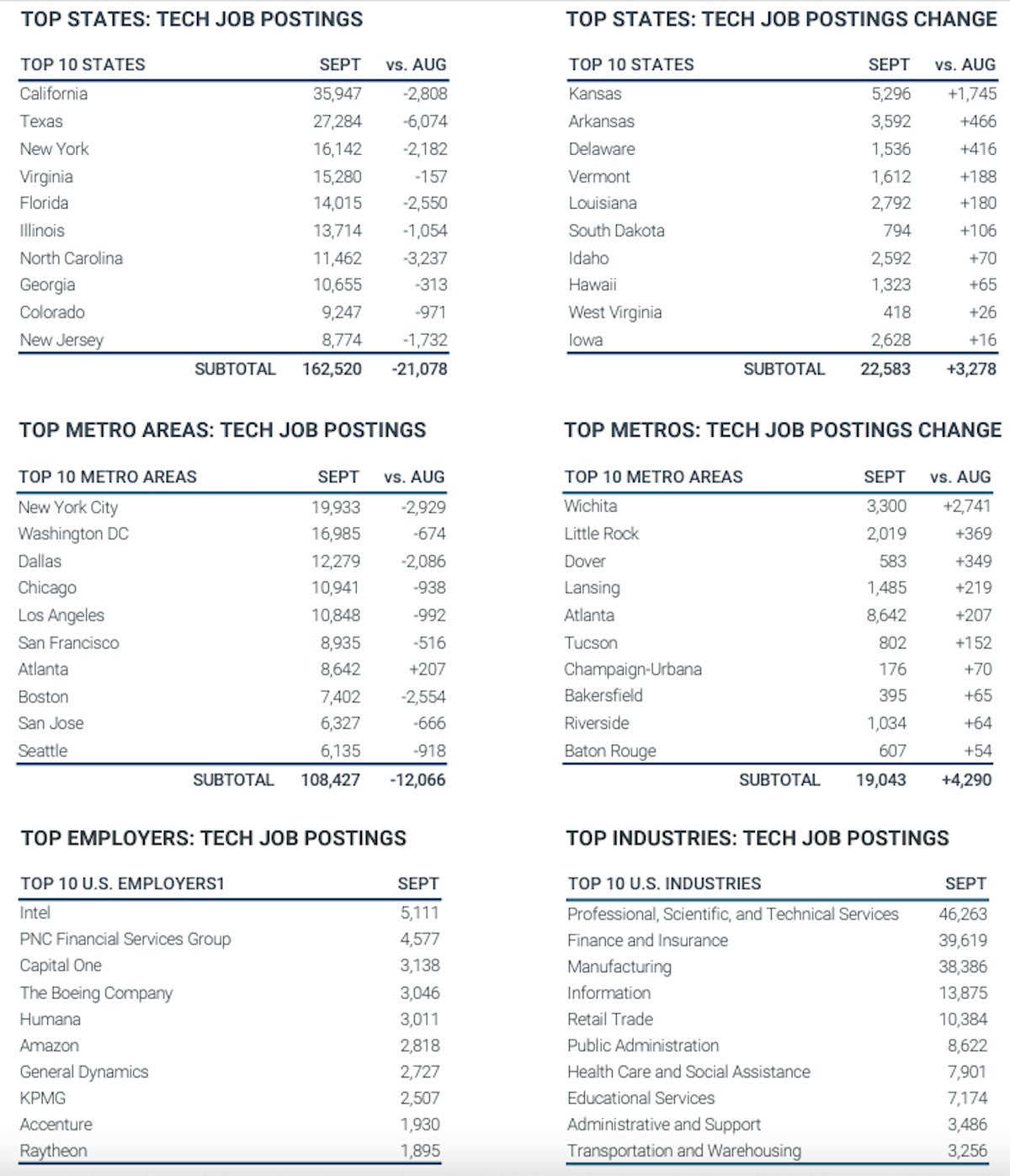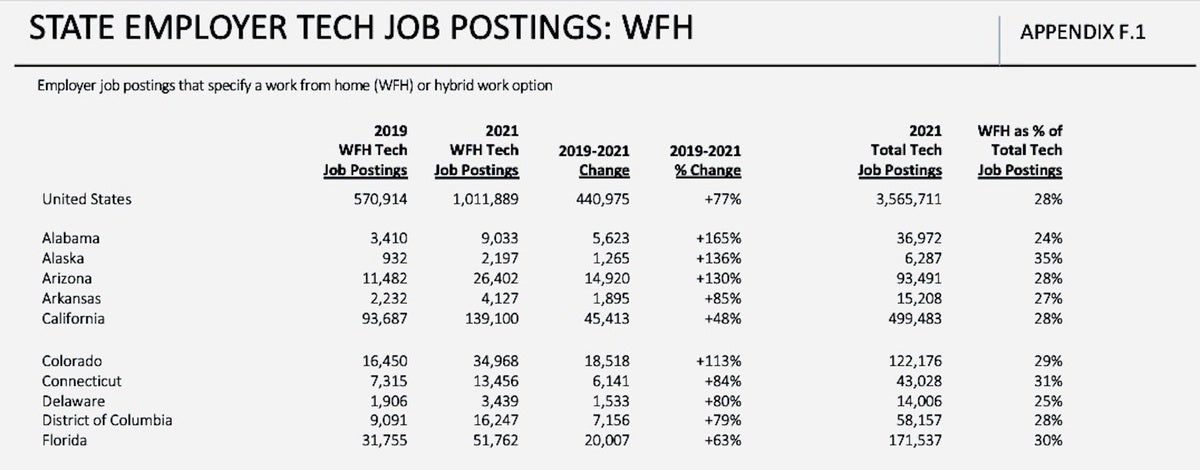With the technology job market riding high and industry unemployment rates close to half that of the overall US, new data from CompTIA, a nonprofit association for the IT industry and workforce, shows the best states for knowledge workers.
CompTIA bases its data on the monthly US Bureau of Labor Statistics (BLS) employment reports.
The top five states in September include California (with 35,947 tech job openings); Texas (27,284 openings); New York (16,142); Virginia (15,280); and Florida (14,015). Illinois was a close sixth, with 13,714 tech job postings. While those states all reported fewer openings in September than August, according to CompTIA, each still reported near record levels of tech jobs.
The top metropolitan areas for tech positions include: New York City (19,933 jobs); Washington DC (16,985 jobs); Dallas (12,279 jobs); Chicago (10,941 jobs); and Los Angeles (10,848 jobs). With the exception of Atlanta, GA, the top 10 metro areas for tech postings also lost jobs over the past two months. New York City, for example saw nearly 3,000 fewer jobs in September than August. Dallas also saw its job number drop by more than 2,000.
Overall, companies added 25,500 technology workers across the US in September, according to the latest data from the BLS. The unemployment rate for technology occupations in September was 2.1%, down slightly from 2.3% in August. But that unemployment remains significantly lower than the national unemployment rate for all occupations, which is 3.5%.
“Stability in tech hiring continues to be an over-arching theme this year,” CompTIA Chief Research Officer Tim Herbert said. “Despite all the economic noise and pockets of layoffs, aggregate tech hiring remains consistently positive.”
And it’s expected to remain strong over the next few years. The BLS predicts overall employment in computer and information technology occupations is projected to grow 15 percent between 2021 and 2031.

More remote areas see an increase in tech job openings
In contrast to large metropolitan areas that have seen fewer tech job offerings, more remote metropolitan areas, such as Wichita, KS., Little Rock, AR, and Dover, DE., all saw growth, according to CompTIA.
Cost of living, business environment and “livability” were all contributing factors to the acceleration in growth in tech employment options in cities and regions outside traditional tech hubs, according to Nancy Hammervik, chief solutions officer at CompTIA.
“It’s rarely just one or two factors, but rather a confluence of contributing factors,” she said. “In a 2021 CompTIA IT Career Insights survey, one in four IT pros cite job flexibility in work hours or location as a driver for initially seeking a career in IT. The pandemic introduced a new variable with work from home and hybrid work arrangements, which undoubtedly influenced tech employment in many metros.”
Given the current state of the economy, cost of living may take on greater importance, according to Hammervik, with workers looking to live and work in areas where their “tech dollar” goes farther. For example, Mobile, AL. instead of San Francisco.
“Beyond economic considerations, tech pros often seek out organizations that are innovative and progressive, that leverage emerging technologies that allow them to work on exciting new projects and that invest in upskilling their employees, offering continued learning and training opportunities to build their skills,” Hammervik said.
Workplace studies conducted by CompTIA and other organizations in recent years showed that employees — including tech workers — have different requirements from their employers in how they approach post-pandemic normalcy, according to Hammervik. Some, for example, want to remain 100% remote; others prefer to combine remote and in-office work; and still others seek other, flexible arrangements that capitalize on the fact technology enables them to work from anywhere.
Another factor that has been trending, Hammervik said, is that while major tech hubs such as Silicon Valley remain the largest sources of venture capital concentration, new funding mechanisms and new tech ecosystems have opened opportunities to launch and grow a tech startup in any number of metro areas.
“Perhaps years ago, a promising tech startup spun out of a state university in the middle of America may have felt the need to relocate to Silicon Valley. Today, that firm may feel confident in scaling their business from where they started,” Hammervik said.
Remote work gains popularity
Last year, Gartner had predicted 31% of all workers worldwide would be remote (either hybrid and fully remote) in 2022. But a more recent Adaptavist survey found 43% working hybrid or fully remotely — with an even greater number wanting more say in where they work (59%), the structure of their work week, and the way productivity is measured.
At the beginning of 2022, about 45% of US employees were working fully remote, according to a January survey by Statista. That represents a dramatic increase from the 17% percent of US employees who worked from home five days or more per week before the pandemic, per Statista.
According to the latest Future Workforce Report from remote work job search site Upwork (based on BLS data):
- In 2022, 25% of the workforce, or 38 million Americans, are currently remote first or mostly remote.
- In 2022, 21% of the workforce, or 32 million Americans, are partly remote and partly on site.
- In 2022, 54% of the workforce, or 82 million Americans, are on site.
According to UpWork, the top remote work positions are:
- Software developers
- WordPress developer
- QA tester
- Graphic designer
- Logo designer
- Presentation designer
- Video editor
- Social media manager
- Marketing manager
- Content strategist
Indeed and SmallPDF weigh in on best states for tech jobs
According to job search site Indeed, the 10 best states for IT work are (not surprisingly): California, New York, Virginia, Texas, Florida, Washington, New Jersey, Pennsylvania, Massachusetts and Illinois. North Carolina came in as a close 11th.
The states cited by Indeed earned their positions on the list because they have several metropolitan technology hubs, a growing number of IT jobs ,and competitive pay for technology positions.
But major metro areas are less important now, according to Victor Janulaitis, CEO of Utah-based research firm Janco Associates. He disagrees with the premise that some states are better for IT pros than others based on local conditions. If the primary factor is the location of the company, then with the move to work from home, technologists can do their jobs in any state, he argued.
“One factor is the implication of the labor and tax laws of the state. For example, if an employee works for a California company but lives in, say, Bend OR., the employer will have to conform with withholdings and taxes for Oregon in addition to California,” Janulaitis said.
The driving factor job seekers should consider, Janulaitis said, is not the state, but the health of companies in that state.
“With the recent cuts at Microsoft and Meta, the Pacific Northwest in not a great labor market,” Janulaitis said. “On the other hand, both Texas and Florida are currently better places to find positions for IT pros With the looming recession, the question will be which states will be able to weather the storm better. States like Illinois, California and New York will be more difficult markets for IT pros as companies continue to exit them.”
Another study, performed by document management company SmallPDF, listed Virginia as the best place for IT workers to get a job. SmallPDF analyzed data such as salaries, employment rates, and vacancies in the tech field across every US state.
It put Virginia on top due to high average wages in the computer and mathematical occupations field with $110,510 a year, 58.44 employed in the field per 1,000 jobs, and the highest current tech vacancies (128.97 openings per 100,000 people) in the industry.
“When measuring the average salary against the average annual rent spend, those employed in the field would only be spending 21.68% of their salary on rent,” SmallPDF said in its study. “Those wanting to work in tech remotely also have lots of options, with 27,563 remote openings available at the time of the study.”
Maryland was second in SmallPDF’s study. The the mid-Atlantic state boasts high salaries of $110,790 on average, 54.35 tech jobs per 1,000 jobs, and 116.27 vacancies for every 100,000 people. The average annual salary and rent spend meant that those in a tech field job would lay out just 19.97% of their salary towards rent, one of the lowest numbers of any state on the list. The state also had 27,139 remote tech openings available for those wanting to work from home.
Washington was in third place with the highest number of jobs in tech per 1,000 (59.32), as well as the highest average salary of any state — $124,000 a year. Washington would have been in first place except it had a lower number of vacancies available: 61.69 per 100,000 people, just half the rate in Virginia. Estimates indicate that 21.24% of average tech wages in the state would go to rent. SmallPDF found 27,546 remote tech jobs available at the time of the study.
“It’s fascinating to see how many states are nowadays offering solid salaries in tech jobs, as well as lots of opportunities, especially in northeast regions of the US,” SmallPDF said in its report.
The worst state in which to work for IT? Mississippi, according to SmallPDF. Mississippi ranked at the bottom because of low tech salaries, which average $70,870 a year; low tech employment with 11.85 per 1,000 jobs; and the lowest number of tech vacancies with only 16.03 vacancies per 100,000 people.
Copyright © 2022 IDG Communications, Inc.
Source by www.computerworld.com































